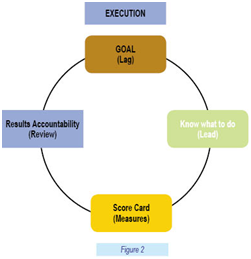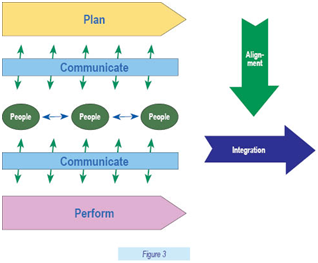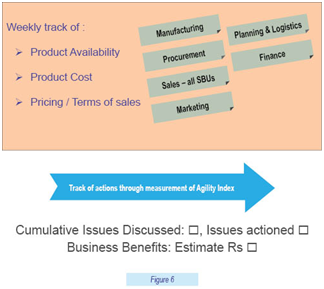By V. Shankar
Chartered Accountant
Strategy is the heart of running and changing a winning business, as we saw in Part I (
BCAJ, March, 2021). Crafting a good strategy is critical for an enterprise to realise its growth and value creation aspirations. This is a capability which successful organisations have in abundance, otherwise they use external experts (aka consultants). What is equally important is Strategy Deployment, i.e. executing the strategy effectively. In many contexts I would say that a higher weightage can be accorded to smart execution. Even a first mover of a strategy may lose out over time if execution does not keep pace. Ford Motor Company, for example, invented cars, but Japanese cars rule the roost in the automobile world now. In this Part II, I will share some aspects about successful execution which I have experienced over the years in running businesses.
The Vision, Mission and Values set, an enterprise typically aspires for a Strategic Target to be achieved in a defined time frame. Towards this goal, a Strategy Map is drawn out which clarifies the strategic objectives and initiatives to be deployed. We have seen how a Strategy Deployment Matrix1 is a great tool to align and integrate individual, team, department and functional goals with that of the enterprise. Now on to some detail on deployment.
LEAD AND LAG
An individual or a Function planning activities by setting goals can use two types – Lead and Lag actions or goals. A Lead action or activity is one which can be executed or influenced and which will result in an outcome or achievement in the desired direction. Lag goals are the ones which are the targeted or intended results. A typical example is the case of a person who wishes to get fitter or become healthier. A Lag goal s/he can have is to lose say five kilograms of weight. The Lead actions or goals which will result in delivering this Lag goal can be (i) eat right, say 2,000 calories per day, and (ii) be active, say walk 10,000 steps daily. The Lag measure is thus the outcome driven by the Lead measure or actions driving the process as indicated in Figure 1 below:

Therefore it is essential to have a healthy mix of Lead and Lag goals while crafting the plan for the year. The goals chosen should be spread over the four perspectives to make a Balanced Scorecard2. With this structure, it lends itself to constructive periodic reviews on how the actions are progressing towards the set goals. This is pictorially depicted in Figure 2 hereunder.

ALIGNMENT AND INTEGRATION
The goals thus planned to be executed in any organisation have to be aligned with the enterprise objectives, at every level and person all the way down. While this will be a vertical flow, it is also important that these are integrated well across functions or departments to make a synergistic impact pulling in the same direction. In all this, robust communication at every level individually or in groups is absolutely critical for the team to comprehend the collective goals and develop a collaborative and committed mind-set. This is outlined in Figure 3.

TOOLS FOR EXECUTION
Having structured and deployed the goals meaningfully, I have utilised a number of effective tools to drive and monitor execution. The purpose is to ensure a discipline in the desired actions being performed as well as to have a structured process in place to review progress. The idea is that attention is given and focused on the exceptions and escalation happens to the appropriate level in time for interventions to help delivery. These are based on two fundamental tenets:

Let us examine some tools which are helpful for the purpose.
ORGANISATIONAL REVIEWS
The strategic target broken down into executable actions on the lines mentioned above will need to be monitored for performance. A broader framework on integrating the review fora and the areas to be covered was touched upon earlier3. This can be detailed out into a review framework as illustrated in Figure 4. The purpose of structuring the review discipline across the organisation is to ensure that not only the right areas are reviewed at the appropriate levels, but also to avoid overlap and superfluous efforts. This process also clarifies the periodicity of each review, the timing, topics as well as the attendance. The team is thus clear on the forum available and the expectation of right feedback.
In these review meetings the agenda being set, it is expected that the concerned will circulate pre-read papers so that the participants can come into the discussion with preparation. That way time is not frittered away in sharing fundamental data and base information. Furthermore, the areas and items which require decision-making in the forum are highlighted. The bulk of the time is therefore focused on decision-making and the team collectively addressing exceptions or areas which record tardy progress.
Performance Review Structure
|
Review
Forum
|
Key
Measures / Objectives
|
Frequency
|
Probable
date and duration
|
Participation
|
Agenda
|
|
Board
|
Strategy
and Operational, Performance Measures
|
5 times a year
|
|
Board members, MD & CEO
|
Policies & Capabilities, Changing Org. Needs, Adherence to
strategic goals
|
|
Executive
Committee
|
Scorecard achievement,
Corporate, Projects, Major issues
|
Monthly
|
1st and 2nd week, 3 hrs.
|
Executive Committee members, MD & CEO, Invitee for specific
session
|
Performance, capabilities, Comp.,
Performance, Changing Org. needs, LT / ST plans, innovation
|
|
ORM (Operational review meeting)
|
Execution of actions planned, Decision on issues
|
Monthly
|
2nd week, full day
|
MD & CEO, COO, EVP Finance, VP Mfg, EVP-TBD, VP-DS, VP-IBD,
VP-HR, GMs, Mkt Heads, Identified, Functional heads, Other Invitees
|
Operational performance, EPM measure, KPI, real contribution,
working capital, Customer Feedback / Supplier’s Inputs, People Issues,
Environment Innovation.
|
|
Cross Functional Teams reviews
|
Result of cross functional Initiatives
|
Monthly
|
3rd week, 2-3 hrs.
|
MD & CEO, COO, EVP-Finance, Cross Functional Team members,
Special Invitees
|
Operational performance, status of projects,
improvement initiatives, Capital projects, Supply chain, Fund Management
|
|
Functional review meetings (Factory / Zones)
|
Operational performance review
|
Monthly
|
1st week, full day
|
Chiefs, Factory heads, Zonal managers, Other department heads,
Special Invitee
|
Divisional performance, Project status,
Market / Customer Issues, Finance Issues, Safety & Env.
|
|
Dept. Review
|
Achievement against
projected performance
|
Weekly / Monthly
|
Specified day, 2-3 hrs
|
Dept. Heads & Dept. Staff as required, Cross Functional Team
members
|
Unit Performance, Capabilities, SHE related
Issues, Initiatives, Supply chain
|
COLOUR CODE TRACKING VISION (CCTV)
The CCTV is a simple yet powerful mechanism to visually comprehend the problem areas in any project or goal delivery. Equally, it also provides comfort at a glance on the projects or areas which are going well. Thus, it does not require intervention at any senior level and can be left to the person / team responsible to deliver as intended. Such a visual representation as portrayed in Figure 5 is quite helpful in any review meeting for the team to quickly pick up and focus on the areas which deserve collective attention.
As can be seen, the CCTV highlights in the traffic signal colours over a period of time the health of the various interventions. Remarks on sluggish progress where applicable are given along with the suggested actions. Discussion can be forthwith focused on the points highlighted in red as well as yellow items with the result that the meetings conclude with specific actions agreed to get the laggard items back on track.
CCTV (colour code tracking vision)
|
Project/
Initiative
|
Original
Target
Date
|
Status
as of
|
Remarks
|
Action
required
|
|
01-
Jan
-21
|
08-
Jan
-21
|
15-
Jan
-21
|
22-
Jan
-21
|
29-
Jan
-21
|
|
|
|
|
|
|
|
|
|
|
|
|
|
|
|
|
|
|
|
|
|
|
|
|
|
|
|
|
|
|
|
|
|
|
|
|
|
|
|
|
|
|
|
|
|
|
|
|
|
|
|
|
|
|
|
|
|
|
|
|
|
|
|
|
|
|
|
|
|
|
|
|
|
|
|
|
|
|
|
|
|
|
|
|
|
|
|
|
|
|
|
|
|
|
|
|
|
|
|
|
ORGANISATIONAL RESPONSIVENESS
In times of uncertainty and volatility, responsiveness in organisations has to be real-time. Often, delayed responses which occur due to blindness in information lead to lost opportunities and may even result in longer-term adverse impact, such as loss of market share. This is being experienced by entities and has been telling since early 2020 due to disruptions from the Covid pandemic.
Businesses can witness significant volatility in terms of cost escalations, supply bottlenecks, changing terms of business, disruption in external environment, etc. This necessitates a change in the way of making business decisions.
An effective way I have experienced in the past is to form a cross-functional team consisting of all key operational departments (vide Figure 6). This team keeps a weekly (even daily) track of changes in the environment and decides appropriate actions to address the changes. For example, the team could introduce a concept of pricing that is based on replacement cost. Based on inputs from the procurement department, the finance team circulates the replacement cost to all the departments, which is used for frequently reviewing pricing decisions in the organisation. This will result in protection from margin erosions in a highly volatile environment. It will also help in timely sourcing of the key materials to cater to the emerging business opportunities.
Cross-functional Action team:
A Weekly feature
Forum for discussion on changing scenario and taking appropriate actions

DRIVING EXECUTION: AGILITY INDEX
It is common to find organisational review fora having a system of making minutes of the meeting. I have found that in doing so some simple tweaks can bring in greater efficiency:
(i) at the end of the meeting, every participant shares the takeaway of his / her actions. Not only does this clarify what each person / team has understood but also instils ownership in delivering actions;
(ii) the secretary of the meeting ensures that the minutes are circulated within 24 hours of the close of the meeting; and
(iii) measuring the speed of execution in terms of ‘Agility Index’.
A score of 9 is assigned to completed actions (Colour Code: Green).
A score of 3 is assigned to actions that are yet to be completed but are in progress (Colour Code: Yellow).
And a score of 1 is assigned to actions that have not been initiated (Colour Code: Red).
The Agility Index (Figure 7) is computed by summing up the item-wise score expressed as a percentage to the total possible, which is the sum of all items times 9 which indicates completion. This, at a glance gives the efficiency of implementation of the agreed actions in an objective manner. This index can also be used to track the action implementation efficiency of Board Meetings as well.
Agility Index
|
Action
Agreed
|
Responsibility
/Owner
|
Timeline
|
Status
|
Tracker
points
|
|
|
|
|
|
|
|
1. xxx
|
ABC
|
15-Apr
|
|
9
|
|
|
|
|
|
|
|
2. yyy
|
PQR
|
18-Apr
|
|
3
|
|
|
|
|
|
|
|
3. zzz
|
XYZ
|
21-Apr
|
|
1
|

DIGITAL ENABLERS
Digital age now has pervaded all aspects of life at work and in personal domain. Digital technologies such as Cloud, Mobility, Internet of Things, Artificial Intelligence and Virtual Reality are enabling organisations to reimagine and transform businesses. A plethora of tools and information is available through the digital platform greatly enhancing execution capability. In agriculture, for example, gone are those bad old days like the protagonist in Do Bigha Zameen physically labouring away. In advanced agriculture economies such as USA and Brazil, farmers control the entire farming through electronic and mechanical processes using drones, hi-tech machines4, etc. to make the right decisions based on soil and environmental insights and practice precision farming. All this sitting in a control room away from the field! AI and predictive technologies have enabled to customise practices with understanding of future weather and pest changes. Manufacturing operations are guided today by Computer-aided Design, Big Data, Machine Learning, Robotics, etc. which significantly improve productivity and quality. All this, however, has led to an explosion of information available and it is crucial to design internal systems to process and focus these for effective execution.
EXECUTION: A DISCIPLINE
Authors Larry Bossidy and Ram Charan wrote in their remarkable book5 that ‘execution is a specific set of behaviours and techniques that companies need to master in order to have competitive advantage’. Execution is therefore a discipline which ensures that the strategy to achieve the strategic goals of the enterprise is duly deployed and implemented to have sustained competitive advantage. Therefore, we can conclude that Performance is Strategy plus EXECUTION.
This is the last article in this series by Mr. V. Shankar. For the previous five articles, please refer to the BCAJ issues of January 2020, March 2020, June 2020, August 2020 and March 2021
References
1. Strategy: The Heart of Business – Part I, BCAJ, March, 2021, Page 13
2. ‘The Balanced Scorecard: Translating Strategy into Action’ by David P. Norton and Robert S. Kaplan
3. Governance & Internal Controls: The Touchstone of Sustainable Business – Part II, BCAJ, June, 2020, Page 15
4. https://youtu.be/FNn5DB1Zen4
5. ‘Execution: The Discipline of Getting Things Done’ by Larry Bossidy and Ram Charan

















